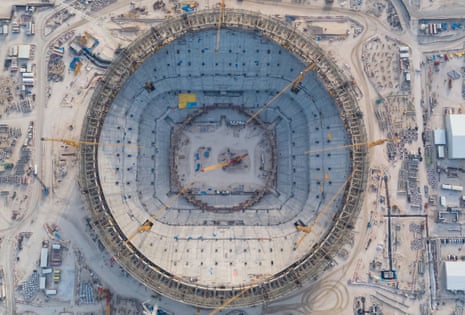Last November Jürgen Klopp criticised the “crazy” demands made on top footballers, who can find themselves with only two weeks off a year from a job that is physically and mentally gruelling. He said football administrators should “think about the players and not about their wallet.” The Liverpool manager is right, of course, but there is a more pressing reason why the authorities need to curtail their expansionist tendencies: our planet cannot sustain it.
As is the case for many of us, the people who run football are apparently in an ominous state of denial about the climate emergency. The United Nations Intergovernmental Panel on Climate Change has made it clear that we need to transition to a decarbonised world rapidly, hitting global greenhouse gas (GHG) reduction targets of 45% by 2030 and complete carbon neutrality by 2050. But not all carbon footprints are created equal in our unequal world and, since some are easier to reduce than others, those of us in disproportionately polluting countries will have to reduce our carbon footprints by 90% within a decade. Doing so will demand a radical transformation of every feature of society, including football.
Football has its head deeply in the sand regarding what this transition will really mean. This is not just a leadership problem. Academic research and journalistic discourse on football’s carbon footprint is virtually non-existent, but even from a distance you can see the (melting) iceberg fast approaching.
Like most capitalist enterprises, the football business is a growth industry, but very few industries can sustain limitless growth in the 21st century and football needs to reshape itself accordingly. Can millions of people still drive to matches every week? Should we continue to revere away fans who heroically venture to faraway towns, countries and continents to support their team? How many people’s carbon budget will allow them to get on a plane to attend an international match? Or to buy the industrially processed meat sandwiches, oil-soaked plastic paraphernalia and fast fan fashion on sale at grounds? Does the practice of releasing three new strips and heaps of tat every season survive the push to a zero emissions world? Is there a place for the polyester half-and-half scarf? What of the increasing ownership of clubs by energy companies and petrostates? How many of football’s biggest sponsors – Qatar Airways, Continental, Castrol, Gazprom, McDonald’s, Emirates, Coca-Cola – have any significant place in a carbon neutral world? What will football do when they are gone?
In a saner world, these questions would be discussed daily. Emergency conferences would be convened by every national FA, regional confederation and Fifa. Those of us who love football would be working to figure out what should be salvaged from the sinking ship of football as we know it.
Modern football is unsustainable. Simply put, there needs to be a lot less of it. If affluent, fossil fuel-gorging countries are to decarbonise in a little over a decade, we must make difficult choices about what to do with the limited carbon budget we each have left. Writing in his book Heat, George Monbiot estimated this to be 1.2 tonnes of carbon dioxide per person per yeah in the UK.
Yet, what is on the mind of the global football industry? Growth, naturally. Fifa recently expanded the men’s World Cup from 32 to 48 teams, the Women’s World Cup from 24 to 32 teams and the Club World Cup from seven to 24 teams. The regional confederations have been similarly expansionist. Having increased the size of the European Championship and created a new tournament in the form of the Nations League, Uefa are now looking to increase the number of teams participating in its existing club competitions and recently announced the creation of a third-tier annual tournament involving 32 teams. The Concacaf Gold Cup has expanded from 12 to 16 teams; and both the Africa Cup of Nations and the AFC Asian Cup have expanded from 16 to 24 teams.
All of this will increase football’s already vast carbon footprint. A return trip from New York to London produces roughly 1.2 tonnes of CO2 per passenger – one fan’s entire annual budget gone in one shot. The idea of jetting off on a cheap flight for a few days to watch your team play overseas will have to become a thing of the past for all but a very few. The ballooning plans for football’s future are predicated upon millions more fans travelling on greenhouse gas-spewing planes into perpetuity. Football’s governing bodies should be preparing for the future we have created for ourselves, not the utopian, blinkered continuation of an unsustainable way of life.
When Fifa briefly considered fast-tracking the expansion of the men’s World Cup from 2026 to 2022, its report on the matter focused squarely on the many logistical problems associated with Qatar’s inability to accommodate these extra games and people and, naturally, the financial windfall that awaited if these obstacles could be surmounted. Nowhere in the report are emissions factored into the equation because, despite their greenwashing rhetoric, Fifa does not include the emissions from fans flying to and from tournaments in their carbon estimates, which is comparable to a dieter carefully counting their daily calories but choosing to exclude the bucket of KFC they eat every night before bed. Not mentioned in the report were the words: “environment”, “climate change”, “climate emergency,” “greenhouse gases” or “carbon footprint”.
Football’s governing bodies all focus on their obligation to promote and develop the sport but this kind of growth is no longer possible. If we take the steps required to address the climate crisis, by the time the 2026 World Cup kicks off, millions of fans will not be able to fly to North America. Nor will they be able to travel several thousands of kilometres between host cities in northern Canada and southern Mexico. It will be too great a violation of one’s annual carbon footprint ration. This is true, regardless of how we feel about it.
None of us want this feast of consumerist expansion to come to an end, but we also don’t want the blood of the planet on our hands. We don’t want to be the generation whose historical legacy is that we knew we were destroying our planet forever and chose to do nothing, because it made our lives a little more boring or difficult.

Soon, we’re going to have to decide how important football really is. The heartening news is that if we make a belated but fiercely concerted and committed effort to prepare, more options will be available to us and we will have the chance to actively participate in the invention of football’s future. The scheduling mayhem caused by the coronavirus pandemic has presented us with a previously unimaginable opportunity to fundamentally reimagine the congested football calendar. If we use this unprecedented chance to plan, show foresight and think realistically about the role football might play in our collective futures, perhaps we can still have the world and World Cups.
A few easy but necessary first steps would be to say no to all expansion, embrace a less-is-more philosophy and begin an earnest conversation about how much football we want, need and can afford. Spreading every annual league season and cup competition over a two-year period would be a productive starting point. A World Cup with 16 teams instead of 48 sounds about right. One or two games a day instead of four, five, or six? That’s plenty. We can all live with that.

Comments (…)
Sign in or create your Guardian account to join the discussion